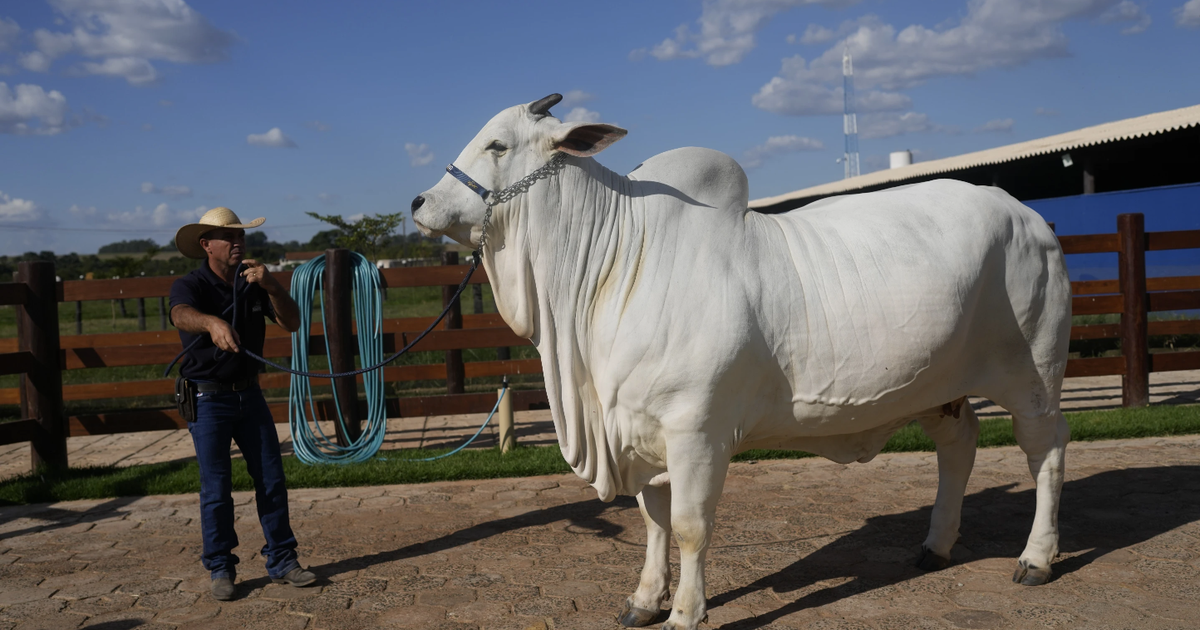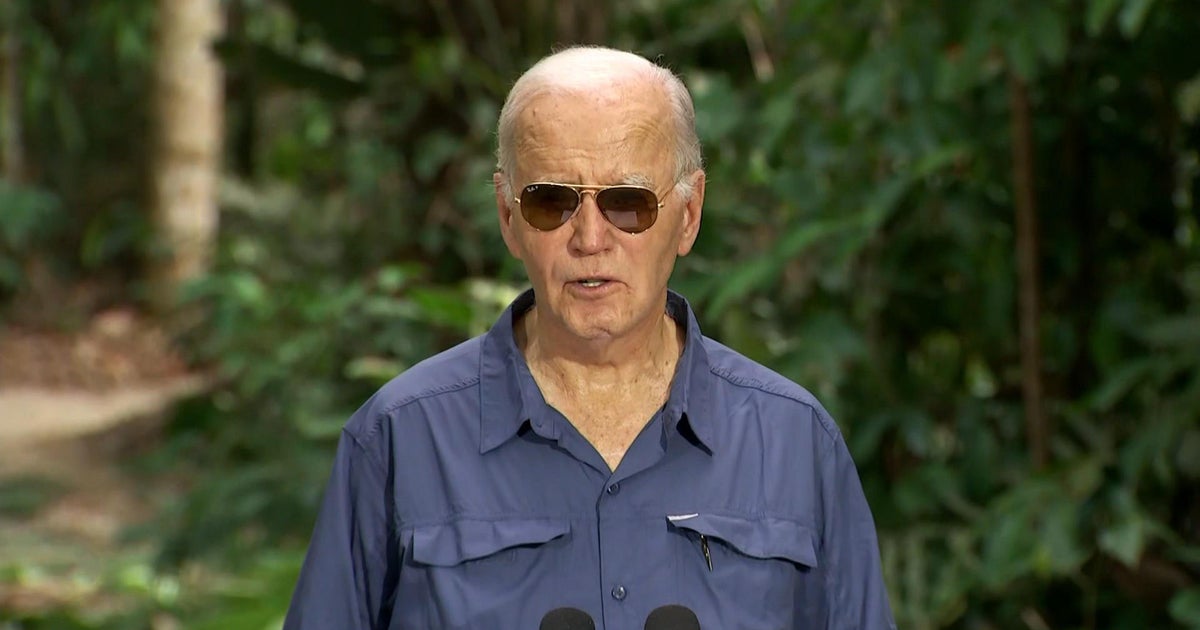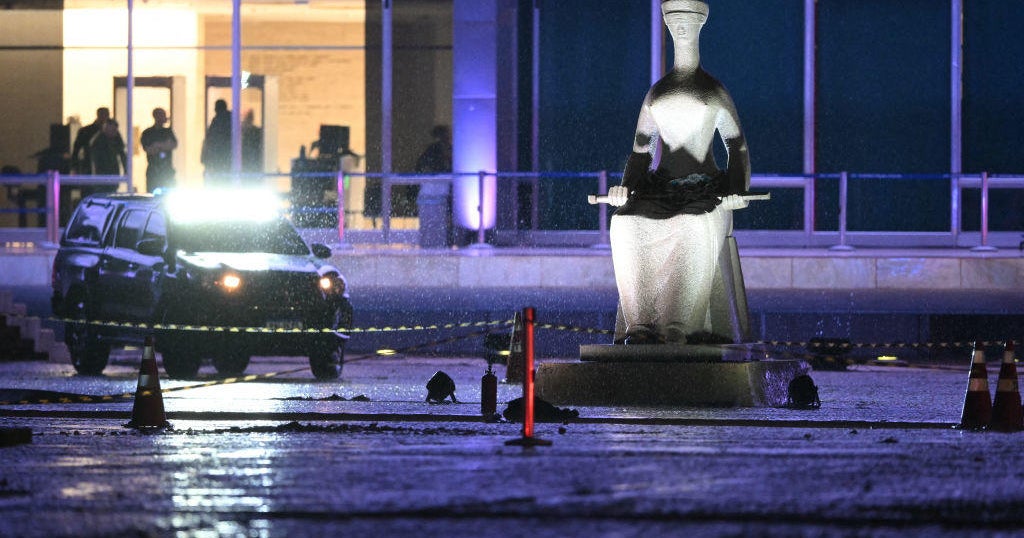CBS News
Brazil unveils $4 million supercow, twice as meaty as others of her breed

Brazil has hundreds of millions of cows, but one in particular is extraordinary.
Worth $4 million, Viatina-19 FIV Mara Movéis is the most expensive cow ever sold at auction, according to Guinness World Records. That’s three times more than the last recordholder’s price. And — at 1,100 kilograms (more than 2,400 pounds) — she’s twice as heavy as an average adult of her breed.
Along a highway through Brazil’s heartland, Viatina-19’s owners have put up two billboards praising her grandeur and beckoning people to make pilgrimages to see the supercow.
Climate scientists agree that people need to consume less beef, the largest agricultural source of greenhouse gasses and a driver of Amazon deforestation. But the cattle industry is a major source of Brazilian economic development and the government is striving to conquer new export markets. The world’s top beef exporter wants everyone, everywhere to eat its beef.
The embodiment of Brazil’s cattle ambitions is Viatina-19, the product of years of efforts to raise meatier cows. Prizewinners are sold at high-stakes auctions — so high that wealthy ranchers share ownership. They extract the eggs and semen from champion animals, create embryos and implant them in surrogate cows that they hope will produce the next magnificent specimens.
“We’re not slaughtering elite cattle. We’re breeding them. And at the end of the line, going to feed the whole world,” one of her owners, Ney Pereira, said after arriving by helicopter to his farm in Minas Gerais state. “I think Viatina will provide that.”
The snow-white cow’s eye-popping price stems from how quickly she put on vast amounts of muscle, from her fertility and — crucially — how often she has passed those characteristics to her offspring, said Lorrany Martins, a veterinarian who is Pereira’s daughter and right hand. Breeders also value posture, hoof solidity, docility, maternal ability and beauty. Those eager to level up their livestock’s genetics pay around $250,000 for an opportunity to collect Viatina-19’s egg cells.
“She is the closest to perfection that has been attained so far,” Martins said. “She’s a complete cow, has all the characteristics that all the proprietors are looking for.”
In Brazil, 80% of the cows are Zebus, a subspecies originating in India with a distinctive hump and dewlap, or folds of draping neck skin. Viatina-19 belongs to the Nelore breed, which is raised for meat, not milk, and makes up most of Brazil’s stock.
The city of Uberaba, where Viatina-19 lives, holds an annual gathering called ExpoZebu that bills itself as the world’s biggest Zebu fair. Held several weeks ago, it was a far cry from the Brazil that’s imagined abroad. The dress code was boots, baseball caps and blue jeans. Evening concerts drew 10,000 spectators belting out their favorite country songs. But the main attraction was the daily cattle shows where cows compete for prizes that boost an animal’s auction price.
The most prestigious auction is called Elo de Raça, held April 28. As the first cow entered the paddock, speakers blared Queen’s “We Are the Champions.” But that cow was a mere appetizer before this year’s starlet, Donna, and three of her clones; the final sale price put her total value at 15.5 million reais ($3 million.)
A commodities boom in the 2000s turbocharged Brazilian agriculture, especially with a rising China buying soy and beef. Today, agriculture’s influence extends to Brazil’s Congress and the national consciousness. And Brazil, along with the U.S., is at the forefront of cattle genetics.
Showstoppers like Donna and Viatina-19 are rarities in Brazil, which has more than 230 million cows, according to the USDA. It’s the world’s largest beef cattle population, and that’s problematic; huge swaths of Amazon rainforest have been slashed to create pasture, releasing carbon stored in trees. And cows belch methane that’s far worse for the climate.
Genetic improvements that reduce cows’ slaughtering age are helpful but limited ways to reduce warming. Simpler, more effective measures include planting better grass for grazing and regularly moving cattle from pasture to pasture, said Beto Veríssimo, an agronomist and the co-founder of an environmental nonprofit called Imazon.
Meanwhile, President Luiz Inácio Lula da Silva has been working to open new markets. Last month, he met Prime Minister Fumio Kishida of Japan, home to the premium, marbled Wagyu beef; he urged his counterpart to taste Brazilian meat and become a believer.
“Please,” he said, addressing his vice president at the event, “take Prime Minister Fumio to eat steak at the best restaurant in Sao Paulo so that, the following week, he starts importing our beef.”
Clones coming soon
Down the highway from the Elo de Raça auction is the laboratory of the company Geneal Animal Genetics and Biotechnology. In a small pen behind it, a cloned calf recently lay in the sunshine, still too unsure of its newborn legs to stand. Another born by cesarean section 20 minutes earlier pressed backward against a stall’s rear wall, unsettled by this strange new world. Clones of Viatina-19 are due in a few months, said Geneal’s commercial director, Paulo Cerantola.
Some ranchers wouldn’t want a big herd of her clones. High-maintenance cows like Viatina-19 aren’t profitable on a large, commercial scale because they couldn’t meet their energy needs from grass alone, said P.J. Budler, international business manager for Trans Ova Genetics, an Iowa-based company focused on improving the bovine gene pool.
“For the environment and the resources that it would take to run a cow like (Viatina-19), she fits the mold ideally, but she’s not the answer for all cattle everywhere,” Budler said.
Viatina-19’s owner, Pereira, said she gets special treatment to boost egg cell production, but would thrive were she put to pasture — where almost all his elite cattle feed.
Meanwhile, Viatina-19 is pregnant for the first time, and Pereira’s eyeing expansion; her egg cells have sold to Bolivian buyers and he wants to export to the United Arab Emirates, India and the U.S.
His veterinarian daughter, Martins, is looking even farther ahead.
“I hope she is the basis for an even better animal in the future, decades from now,” she said.
CBS News
How to watch the Minnesota Vikings vs. Chicago Bears NFL game today: Livestream options, more

Getty Images
The Minnesota Vikings will take on the Chicago Bears today. The Vikings are currently 8-2, an impressive run so far this season, and will be looking to add a fourth win to their current streak after last Sunday’s 23-13 win against the Tennessee Titans. The Bears, on the other hand, are entering this game on the heels of a four-game losing streak after a tough 20-19 loss against the Green Bay Packers last Sunday.
Here’s how and when you can watch the Vikings vs. Bears game today, whether or not you have cable.
How and when to watch the Minnesota Vikings vs. Chicago Bears
The Vikings vs. Bears game will be played on Sunday, November 24, 2024 at 1:00 p.m. ET (11:00 a.m. PT). The game will air on Fox and stream on Fubo and the platforms featured below.
How and when to watch the Minnesota Vikings vs. Chicago Bears game without cable
You can watch this week’s NFL game on Fox via several streaming services. All you need is an internet connection and one of the top options outlined below.
Fubo offers you an easy, user-friendly way to watch NFL games on CBS, Fox, NBC, ABC, ESPN, and NFL Network, plus NCAA football channels. The Pro tier includes 200+ channels and unlimited DVR, while the Elite with Sports Plus tier adds NFL RedZone and 4K resolution. New subscribers get a seven-day free trial and all plans allow streaming on up to 10 screens simultaneously.
You can watch today’s game with a subscription to Sling’s Orange + Blue tier, which includes ESPN, ABC, NBC, and Fox. The plan offers 46 channels with local NFL games, nationally broadcast games and 50 hours of DVR storage. For complete NFL coverage, add Paramount+ to get CBS games, or upgrade with the Sports Extra add-on for additional sports channels like Golf Channel, NBA TV and NFL RedZone.
Watching NFL games, including Fox broadcasts, is simple with Hulu + Live TV, which includes 90 channels, unlimited DVR storage, and access to NFL preseason games, live regular season games and studio shows. The service includes ESPN+ and Disney+ in the subscription.
Want to watch today’s game live on your smartphone? If so, NFL+ streaming service is the solution you’re looking for. It lets you watch NFL Network and out-of-market games on mobile devices, with an upgrade option to NFL+ Premium that includes NFL RedZone for watching up to eight games simultaneously. Note that NFL+ only works on phones and tablets, not TVs.
CBS News
How to watch the Detroit Lions vs. Indianapolis Colts NFL game today: Livestream options, more

Nic Antaya/Getty Images
The Detroit Lions will face off against the Indianapolis Colts today. The Lions enter this game as top contenders with a near-perfect record of 9-1 so far this season. The Colts, who are 5-6 this season, could have a tough game on their hands against the Lions but will be looking to rack up another win after prevailing over the New York Jets in a tight game last Sunday.
Here’s how and when you can watch the Colts vs. Lions game today, whether or not you have cable.
Here’s how and when to watch the Detroit Lions vs. Indianapolis Colts
The Lions vs. Colts game will be played on Sunday, November 24, 2024 at 1:00 p.m. ET (11:00 a.m. PT). The game will air on Fox and stream on Fubo and the platforms featured below.
How and when to watch the Detroit Lions vs. Indianapolis Colts game without cable
You can watch this week’s NFL game on Fox via several streaming services. All you need is an internet connection and one of the top options outlined below.
Experience NFL action like never before with Fubo’s comprehensive sports streaming platform. From Sunday showdowns to primetime matchups, catch every NFL game across major networks including CBS, Fox, NBC, ABC, ESPN and NFL Network. Choose the Pro package to unlock 200+ channels and limitless DVR storage, or elevate your game-day experience with the Elite with Sports Plus package, featuring NFL RedZone’s commercial-free scoring highlights and stunning 4K quality.
Test drive the service with a no-commitment seven-day free trial, and share the excitement with family and friends — Fubo supports simultaneous streaming on up to 10 devices, so everyone can watch their favorite teams.
You can watch today’s game with a subscription to Sling’s Orange + Blue tier, which includes ESPN, ABC, NBC, and Fox. The plan offers 46 channels with local NFL games, nationally broadcast games, and 50 hours of DVR storage. For complete NFL coverage, add Paramount+ to get CBS games, or upgrade with the Sports Extra add-on for additional sports channels like Golf Channel, NBA TV and NFL RedZone.
Watching NFL games, including Fox broadcasts, is simple with Hulu + Live TV, which includes 90 channels, unlimited DVR storage, and access to NFL preseason games, live regular season games and studio shows. The service includes ESPN+ and Disney+ in the subscription.
Want to watch today’s game live on your smartphone? If so, NFL+ streaming service is the solution you’re looking for. It lets you watch NFL Network and out-of-market games on mobile devices, with an upgrade option to NFL+ Premium that includes NFL RedZone for watching up to eight games simultaneously. Note that NFL+ only works on phones and tablets, not TVs.
CBS News
How to watch the New England Patriots vs. Miami Dolphins NFL game today: Livestream options, more

Getty Images
The New England Patriots will face off against the Miami Dolphins in a game today at the Hard Rock Stadium in Miami. The Patriots have had an uneven season so far, coming into the game with a record of 3-8, including a 28-22 loss to the Los Angeles Rams on November 17. The Dolphins, however, haven’t fared much better this season as they enter the game with a record of 4-6, although they are coming off two wins in a row, the latest against the Las Vegas Raiders last weekend.
Keep reading to find out how and when to watch the New England Patriots vs. Miami Dolphins game today, even without cable.
CBS, Paramount+ and CBS Essentials are all subsidiaries of Paramount Global.
How and when to watch the New England Patriots vs. Miami Dolphins game today
The New England Patriots vs. Miami Dolphins game will be played on Sunday, November 24, 2024 at 1:00 p.m. ET (10:00 a.m. PT). The football game will be shown on CBS and streamed on Paramount+ and the platforms noted below.
How and when to watch the New England Patriots vs. Miami Dolphins game without cable
While CBS is available with many basic cable packages, you’ll have other viewing options, too for the Patriots-Dolphins game. Just understand that the below streaming options will require the use of an internet provider:
Paramount+: Watch CBS-aired NFL games without cable
With Paramount+ you’ll have multiple viewing options to choose from. You can catch NFL games on the Paramount+ Essential tier for just $7.99 each month or you can watch college football with a Paramount+ with Showtime subscription for $12.99 monthly. In addition to live streams of NFL games airing on CBS, you’ll get to watch additional live sporting events including NCAA college football, PGA Tour golf, soccer and more.
Get started with Paramount+ here today.
Amazon Prime Video: Add Paramount+ to your existing subscription
Already have an Amazon Prime Video account? Simply add Paramount+ to your current subscription to watch all the CBS-aired NFL games in addition to Paramount+ originals. The same prices from above apply, depending on which tier you choose. Not sure which is best for you? Don’t worry. Both options come with a free seven-day trial that can help you decide.
Watch the Patriots-Dolphins game on Amazon Prime Video.
Fubo: Watch the Patriots-Dolphins game for free
Looking for an inexpensive way to watch football? Fubo could be the best way to do so. The live TV streamer is currently offering a seven-day free trial and $30 off of your first month’s subscription. Once subscribed, you’ll gain access to all of their live sporting events immediately. And there will be a lot to choose from. Not only does Fubo come with access to NFL games airing on your local CBS channel, it also includes Fox Sunday NFC games, “Sunday Night Football” on NBC, “Monday Night Football” on ABC and ESPN and all of the games that air on the NFL Network. So don’t wait.
Get started with Fubo online now.










